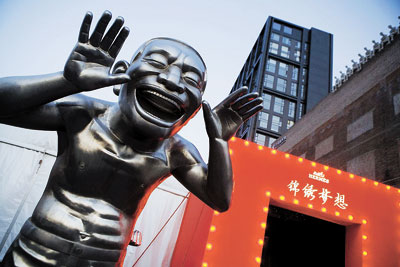
ART galleries should embrace the public, connecting the world of art to the public, said Yang Chao, president of the Xi’an Art Museum.
“This concept should be held by all art museums and galleries. Tear down the ‘walls’ of the galleries, and bring the exhibitions to the public squares,” Yang said at the 2nd China Private Art Museum Forum, which was held at the Shanghai Long Museum on Sept. 12.
The forum was jointly held by cultural departments and several private art galleries in China. Compared to the first forum, this year’s topic focused more on how to attract the general public to galleries. Leaders and experts from many art galleries around the world and across the country attended the forum and shared their experiences promoting art galleries among the public.
The Fukutake Foundation was the financial supporter of the private art galleries and museums on more than 300 islands in Seto Nai Kai (Seto Inland Sea) in Japan. Known as the Benesee Art Site, the art galleries and museums target different art genres and visitors and attract a large number of visitors from Japan and other parts of the world every year.
“We attract visitors through art activities with different styles and specialties, and these activities also serve local residents well in terms of improving their lives and meeting their demands for art,” said Kenjiro Kaneshiro, CEO of the foundation.
Public sculptures are another highlight of the islands. Unlike the public sculptures in China, which are often criticized by the public, the sculptures on the islands were very welcomed by the locals.
“One of the keys to their success was that we hosted these activities and creations together with the local residents. In this way, we made sure that the artworks were widely accepted and loved by the local residents,” said Kaneshiro. In order to promote their works, the foundation has done much research in the area, collecting advice and opinions from local senior citizens. “I think that understanding the local seniors is very important. They have more life experience and have lived here for a long time. These senior residents like our works because our works help them illustrate their experiences for younger people.”
The Overseas China Town (OCT) Group has also tried to promote similar projects in Pujiang OCT since 2007 with the hope of connecting the art to the public. “Several years ago, we had a piece of art by Sui Jianguo built in Pujiang OCT. Some residents asked a security guard about the artwork, but the guard said he had no idea,” said Yi Qian, president of the OCT Contemporary Art Terminal in Shenzhen. “However, at this year’s Shenzhen Sculpture Biennale, a friend of mine noticed that the security guards were introducing the artworks to the public. This is clearly an improvement of the city and its residents and shows the great efforts being made by the galleries and artists. ”
In fact, many art galleries around the world are facing a series of challenges, not just the challenges of displaying art. Due to the economic recession, many galleries in Europe have received much less funding from the government and have had to depend on themselves for survival. Therefore, many heads of these art galleries are no longer art experts but are management professionals with strong financial backgrounds.
The Museum of Flamenco Dance in Spain is one of those museums that rely heavily on ticket income and sales profits. “As a private museum for cultural heritage, we focus on promoting flamenco among the public through dance experiences, books, videos and activities. It is not just exhibitions. We want all people to feel the joy of dancing,” said Kurt Grotsch, president for the museum.
Recently, an increasing number of private art museums and galleries have been established across China, and many of them are also exploring effective ways of promoting art among the public. “It might still take Chinese art galleries five to 10 years before they experience wide influence among the public,” said Grotsch.
For example, the Yinchuan Contemporary Art Museum used to invite 1,000 families to make art at the museum while the Himalayas Art Museum in Shanghai launched a “mobile museum” project.
“Private art museums in China face difficulties because there is not a mature art industry. Private museums in China need some creative and bold entrepreneurs to move in, and it might take three generations to make the needed fundamental changes to the industry,” said Lu Peng, president of the Chengdu Contemporary Art Museum.
(Wang Yuanyuan)
|

